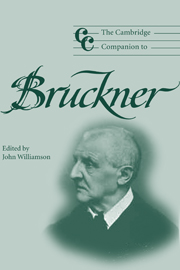Book contents
- Frontmatter
- Part I Background
- Part II Choral music
- Part III The symphonist
- 7 The Brucknerian symphony: an overview
- 8 Bruckner's symphonies – a reinterpretation: the dialectic of darkness and light
- 9 Programme symphony and absolute music
- 10 Bruckner editions: the revolution revisited
- 11 Bruckner and the symphony orchestra
- 12 Between formlessness and formality: aspects of Bruckner's approach to symphonic form
- 13 Formal process as spiritual progress: the symphonic slow movements
- 14 Bruckner and harmony
- Part IV Reception
- Notes
- Select bibliography
- Index
7 - The Brucknerian symphony: an overview
from Part III - The symphonist
Published online by Cambridge University Press: 28 September 2011
- Frontmatter
- Part I Background
- Part II Choral music
- Part III The symphonist
- 7 The Brucknerian symphony: an overview
- 8 Bruckner's symphonies – a reinterpretation: the dialectic of darkness and light
- 9 Programme symphony and absolute music
- 10 Bruckner editions: the revolution revisited
- 11 Bruckner and the symphony orchestra
- 12 Between formlessness and formality: aspects of Bruckner's approach to symphonic form
- 13 Formal process as spiritual progress: the symphonic slow movements
- 14 Bruckner and harmony
- Part IV Reception
- Notes
- Select bibliography
- Index
Summary
Types, characteristics, and schemas
In a study of the symphony published in the 1960s, Bruckner was subjected to a unique treatment. In place of the consideration of whole works applied to other composers, Deryck Cooke described a ‘composite’ Bruckner symphony: the Adagio of the Seventh, the Scherzo of the Eighth, and the outer movements of the Third (thereby providing the opportunity to demonstrate the phenomenon of thematic linkage). The strategy was rather clever: by accepting ‘a grain of truth’ in the hoary old idea that Bruckner wrote the same symphony nine times, Cooke demonstrated the variety of ‘characteristics’ that existed within movement ‘types’. Since then, the same strategy has appeared in different contexts, though the question of the ‘schema’ behind Bruckner's symphonies has never entirely been resolved, apart from the firm adherence to four movements. The question affects form far more than other aspect of Bruckner's works, and will be considered in detail in Chapter 12. Nonetheless, attempts to define the ‘essence’ of Bruckner the symphonist have also tended to involve the taxonomy of a fairly narrow collection of characteristics and influences (the contrast between formal schema and characteristics is developed further in Chapter 13 by Margaret Notley).
- Type
- Chapter
- Information
- The Cambridge Companion to Bruckner , pp. 77 - 91Publisher: Cambridge University PressPrint publication year: 2004



